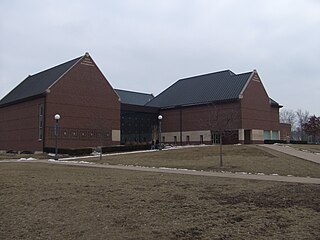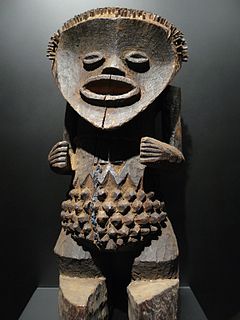Related Research Articles

The University of Pennsylvania Museum of Archaeology and Anthropology—commonly known as the Penn Museum—is an archaeology and anthropology museum associated with the University of Pennsylvania. It is located on Penn's campus in the University City neighborhood of Philadelphia, at the intersection of 33rd and South Streets. Housing over 1.3 million artifacts, the museum features one of the most comprehensive collections of middle and near-eastern art in the world.

The Newark Museum of Art, in Newark, Essex County, New Jersey, United States, is the state's largest museum. It holds major collections of American art, decorative arts, contemporary art, and arts of Asia, Africa, the Americas, and the ancient world. Its extensive collections of American art include works by Hiram Powers, Thomas Cole, John Singer Sargent, Albert Bierstadt, Frederick Church, Childe Hassam, Mary Cassatt, Edward Hopper, Georgia O'Keeffe, Joseph Stella, Tony Smith and Frank Stella.

Birchington-on-Sea is a village in the Thanet district in Kent, England, with a population of 9,961.

The Peabody Museum of Archaeology and Ethnology is a museum affiliated with Harvard University in Cambridge, Massachusetts. Founded in 1866, the Peabody Museum is one of the oldest and largest museums focusing on anthropological material, with particular focus on the ethnography and archaeology of the Americas. The museum is caretaker to over 1.2 million objects, some 900 feet (270 m) of documents, 2,000 maps and site plans, and approximately 500,000 photographs. The museum is located at Divinity Avenue on the Harvard University campus. The museum is one of the four Harvard Museums of Science and Culture open to the public.

James Rowland Ward (1848–1912) was a British taxidermist and founder of the firm Rowland Ward Limited of Piccadilly, London. The company specialised in and was renowned for its taxidermy work on birds and big-game trophies, but it did other types of work as well. In creating many practical items from antlers, feathers, feet, skins, and tusks, the Rowland Ward company made fashionable items from animal parts, such as zebra-hoof inkwells, antler furniture, and elephant-feet umbrella stands.

The William R. and Clarice V. Spurlock Museum, better known as the Spurlock Museum, is an ethnographic museum at the University of Illinois at Urbana-Champaign. The Spurlock Museum's permanent collection includes portions of collections from other museums and units on the Urbana-Champaign campus such as cultural artifacts from the Museum of Natural History and Department of Anthropology as well as historic clothing from the Bevier Collection of the College of Agricultural, Consumer and Environmental Sciences. The Museum also holds objects donated by other institutions and private individuals. With approximately 51,000 objects in its artifact collection, the Spurlock Museum at the University of Illinois at Urbana-Champaign collects, preserves, documents, exhibits, and studies objects of cultural heritage. The Museum’s main galleries, highlighting the ancient Mediterranean, modern Africa, ancient Egypt, Mesopotamia, East Asia, Oceania, Europe, and the Americas, celebrate the diversity of cultures through time and across the globe.
The Lowell D. Holmes Museum of Anthropology began in 1966 as the Museum of Man, at the bequest and initiation of Dr. Lowell Holmes, Professor of Anthropology at Wichita State University in Wichita, Kansas, United States. Over the next 33 years it grew slowly and became known throughout the campus as a small but interesting museum. The collections and exhibitions include cultural items from around the world and archaeological objects predominantly from the American Midwest and Southwest. In 1999, the anthropology department and the museum moved to a new location in Neff Hall. The museum was expanded and Mr. Jerry Martin was hired as Director. This was the first time that the museum had a professional director whose only job was to work with, and develop the museum.

The Museum of Ethnography, in Stockholm, Sweden, is a Swedish science museum. It houses a collection of about 220,000 items relating to the ethnography, or cultural anthropology, of peoples from around the world, including from China, Korea, South and Southeast Asia, the Pacific region, the Americas and Africa. The museum is situated in Museiparken at Gärdet in Stockholm. Since 1999, it is a part of Swedish National Museums of World Culture and is also hosting the Sven Hedin Foundation. The museum is open Tuesday to Sunday 11:00AM – 5:00 PM, and Wednesdays 11:00 AM – 8:00 PM and is closed on Mondays.

The Weltmuseum Wien in Vienna is the largest anthropological museum in Austria, established in 1876. It currently resides in the Hofburg Imperial Palace and houses more than 400,000 ethnographical and archaeological objects from Asia, Africa, Oceania, and America. Since November 2014 the museum was closed due to renovation and was reopened on the 25th of October 2017.

Tribal art is the visual arts and material culture of indigenous peoples. Also known as non-Western art or ethnographic art, or, controversially, primitive art, tribal arts have historically been collected by Western anthropologists, private collectors, and museums, particularly ethnographic and natural history museums. The term "primitive" is criticized as being Eurocentric and pejorative.

The National Museum of Ethnography is a museum of ethnography in Warsaw, Poland. It was established in 1888.

Quex Park itself is 250 acres (1.0 km2) of parkland and gardens plus a further 1500 acres of farmed land, with Quex House and other buildings situated just south-east from Birchington-on-Sea near Margate in Kent, England. It houses the Powell-Cotton Museum, and the Waterloo tower, a secular bell tower.

The Powell-Cotton Museum is situated in Quex Park, Birchington, Kent and houses the diverse personal collections of hunter and explorer Percy Powell-Cotton. The museum also contains the collections of Powell-Cotton's two daughters, Antoinette and Diana Powell-Cotton, who shared their father's passion for collecting. The museum, which links to the ground floor of Quex House, now comprises nine galleries dedicated not only to the extensive collection of large mammals, but to many artefacts representing the cultures and traditions of the locations Powell-Cotton visited.
Major Percy Horace Gordon Powell-Cotton, FZS, FRGS, FRAI, JP was an English explorer, hunter and early conservationist, most noted for the creation of the Powell-Cotton Museum in the grounds of his home, Quex Park in Birchington-on-Sea, Kent, England. Powell-Cotton is noted for bringing an extraordinary number of animal specimens back from his travels across Africa, potentially creating the largest collection of game ever shot by one man. Despite this, Powell-Cotton was an early conservationist, helping categorise a wide number of species across the globe. His two daughters, Antoinette Powell-Cotton and Diana Powell-Cotton shared his passion for conservation, pursuing archaeology and anthropology respectively.
Diana Powell-Cotton (1908–1986) and Antoinette Powell-Cotton (1915–1997) were English sisters who worked together as anthropologists.
This is a list of the taxonomic contributions of Major Percy Horace Gordon Powell-Cotton.
This is a filmography of the Powell-Cotton family, including films by Percy Powell-Cotton and Diana and Antoinette Powell-Cotton.
Joyce J. Scott is an African-American artist, sculptor, quilter, performance artist, installation artist, print-maker, lecturer and educator. Named a MacArthur Fellow in 2016, and a Smithsonian Visionary Artist in 2019, Scott is best known for her figurative sculptures and jewelry using free form, off-loom beadweaving techniques, similar to a peyote stitch. Each piece is often constructed using thousands of glass seed beads or pony beads, and sometimes other found objects or materials such as glass, quilting and leather. In 2018, she was hailed for working in new medium — a mixture of soil, clay, straw, and cement — for a sculpture meant to disintegrate and return to the earth. Scott is influenced by a variety of diverse cultures, including Native American and African traditions, Mexican, Czech, and Russian beadwork, illustration and comic books, and pop culture.

The Angolan pavilion, representing the nation of Angola, has participated in the Venice Biennale since 2013. As one of the biennial international art exhibition's national pavilions, Angola mounts a show in a Venetian palazzo outside Venice's Giardini. The first Angolan pavilion, which featured the photography of Edson Chagas, became the first African national pavilion to receive the biennial's top prize, the Golden Lion for best national pavilion. Chagas displayed poster-sized photographs of resituated, abandoned objects and weathered architecture in the Angolan capital of Luanda. Reviewers praised the interplay between the photographed subject matter and the Italian Renaissance artwork that adorned the hosting palazzo's walls. The 2015 Biennale hosted a group show of five Angolan artists on themes of intergenerational dialogue.
References
- ↑ Powell-Cotton Photographic Collection Summary, Cornucopia: Museums Libraries Archives Council Archived 2013-07-07 at archive.today
- ↑ Percy Horace Gordon Powell-Cotton (1866-1940), Southern Sudan, Pitts Rivers Museum
- 1 2 3 Axton, Colin, Movie Film List, Powell-Cotton Museum, Quex Park, 2008
- 1 2 Case-study 1: Powell-Cotton Museum, Oxford Aspire Museums Archived 2013-07-06 at archive.today
- ↑ Diana and Antoinette – Angola 1936 & 1937, Gallery 4, Powell-Cotton Museum, Quex Park, Birchington
- ↑ Tala! Visions of Angola, Press Release, Powell-Cotton Museum, April 2012
- ↑ Tala! Visions of Angola, Special Events and Exhibitions, Powell-Cotton Museum, Quex Park, official website